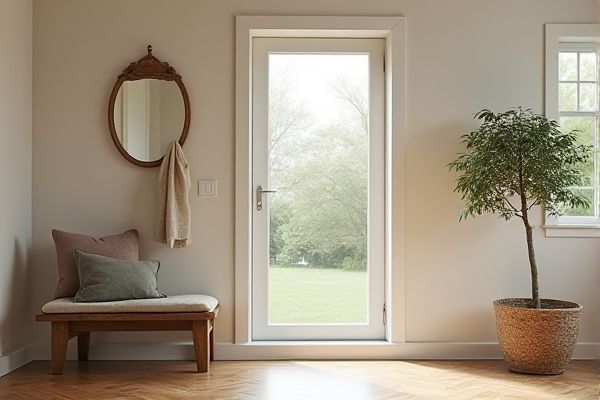
A hall tree with a seat offers practical storage and a convenient place to sit while putting on or taking off shoes, making it ideal for entryways that require multifunctional furniture. Compare the benefits and design options to decide which style best suits Your space and lifestyle; read on to explore more details.
Table of Comparison
| Feature | Hall Tree with Seat | Hall Tree without Seat |
|---|---|---|
| Seating Availability | Includes built-in seat for convenience | No seating option included |
| Storage Capacity | Typically offers under-seat storage space | Storage limited to hooks and shelves |
| Space Requirement | Requires more floor space due to seat | Smaller footprint, ideal for tight spaces |
| Usage | Suitable for sitting while putting on shoes | Primarily for hanging coats and accessories |
| Design Complexity | More complex, combining seating and storage | Simpler design focused on vertical storage |
| Price Range | Generally higher due to added seat feature | Usually more affordable |
Understanding Hall Trees: With and Without Seats
A hall tree with a seat combines storage and convenience, providing a comfortable spot to put on shoes while keeping coats and accessories organized. In contrast, a hall tree without a seat offers a more compact and lightweight solution, ideal for smaller entryways where space is limited. Choosing the right hall tree depends on your space and functional needs, ensuring your entryway stays tidy and efficient.
Key Features of Hall Trees with Seats
Hall trees with seats combine functional storage and seating, featuring built-in benches that provide a convenient spot for putting on or removing shoes. These units often include hooks for coats, shelves for accessories, and cubbies for organizing footwear, optimizing entryway efficiency. The integrated seat enhances comfort and usability, making hall trees with seats a versatile solution compared to hall trees without seats, which primarily offer storage but lack a dedicated seating area.
Key Features of Hall Trees without Seats
Hall trees without seats typically emphasize vertical storage solutions, offering multiple hooks for coats, hats, and bags without occupying floor space for seating. These designs often include shelves or cubbies for shoes and accessories, prioritizing organization over comfort. Your entryway benefits from a sleek, space-saving option that maximizes storage efficiency in smaller areas.
Comparing Storage Capabilities
Hall trees with seats offer enhanced storage capabilities by integrating compartments or drawers beneath the seating area, allowing for convenient storage of shoes, hats, or small accessories. In contrast, hall trees without seats typically provide vertical storage through hooks and shelves but lack hidden or enclosed storage, limiting the capacity for organizing smaller items. Selecting a hall tree with a seat maximizes functionality by combining seating comfort and discrete storage solutions in entryway organization.
Space Efficiency: Which Option Saves More Room?
A hall tree without a seat typically saves more floor space, making it ideal for smaller entryways or tight corridors. Hall trees with seats provide added functionality for sitting and storage but require more room, potentially crowding compact areas. Choosing a seatless design maximizes vertical storage and streamlines the footprint, optimizing space efficiency.
Comfort and Practicality Considerations
A hall tree with seat offers enhanced comfort by providing a convenient spot to sit while putting on or removing shoes, making your daily routine more practical. It often includes storage options like hooks and shelves, combining seating and organization in one piece to maximize space efficiency. In contrast, a hall tree without a seat emphasizes vertical storage, ideal for smaller entryways but may lack the comfort and ease of use that seating provides.
Aesthetics and Design Preferences
Hall trees with seats combine functionality and style, offering a cozy spot for putting on shoes while enhancing entryway aesthetics with more substantial, inviting designs. Hall trees without seats provide a sleeker, minimalist look, ideal for smaller spaces or modern decor emphasizing clean lines and open flow. The choice between the two depends on balancing practical seating needs with desired visual impact and spatial constraints.
Installation and Maintenance Differences
Hall trees with seats typically require more effort during installation due to their larger size and additional components, such as cushions and storage compartments. Maintenance for these models involves regular cleaning of upholstery and inspecting seat attachments to ensure safety. Hall trees without seats are easier to install and maintain, as they primarily consist of hooks and shelves that require minimal upkeep and simpler assembly.
Ideal Use Cases for Each Type
Hall trees with seats are ideal for entryways and mudrooms where sitting down to put on or take off shoes enhances convenience and comfort. They are perfect for households with children or elderly members who benefit from added support while dressing. Hall trees without seats suit smaller spaces or minimalist designs where storage and hanging options are prioritized over seating, making them optimal for tight entryways and modern interiors.
Choosing the Best Hall Tree for Your Home
A hall tree with a seat offers functional seating for putting on shoes and additional storage, enhancing convenience in entryways with limited space. Conversely, a hall tree without a seat provides a sleeker design ideal for narrow or minimalist areas, focusing primarily on hooks and shelves for coats and accessories. Selecting between these options depends on space availability, user needs for seating, and the desired balance between storage and style in your home.
 homyna.com
homyna.com